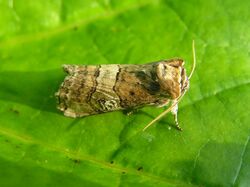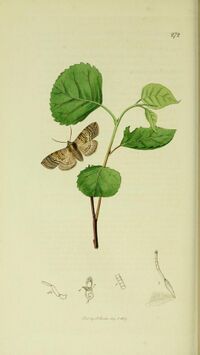Biology:Tethea ocularis
From HandWiki
Short description: Species of false owlet moth
| Tethea ocularis | |
|---|---|

| |
| Scientific classification | |
| Domain: | Eukaryota |
| Kingdom: | Animalia |
| Phylum: | Arthropoda |
| Class: | Insecta |
| Order: | Lepidoptera |
| Family: | Drepanidae |
| Genus: | Tethea |
| Species: | T. ocularis
|
| Binomial name | |
| Tethea ocularis | |
| Synonyms | |
| |
Tethea ocularis, the figure of eighty, is a moth of the family Drepanidae. The species was first described by Carl Linnaeus in his 1767 12th edition of Systema Naturae. It is found throughout Continental Europe and has a scattered distribution in England and Wales, although it is absent from Scotland and Ireland.
The wingspan is 35–45 mm; the dark brown forewings being marked with dark-centred white stigmata which do look rather like the number 80. The hindwings are grey. The species flies from May to July[1] and is attracted to light and sugar.
The grey and white larva feeds on poplar and aspen. The species overwinters as a pupa.
Subspecies
- Tethea ocularis ocularis
- Tethea ocularis ocularis amurensis (Warren, 1912) (Russian Far East, north-eastern and northern China, Mongolia, Korea)
- Tethea ocularis opa Zolotuhin, 1997 (Uzbekistan, China: Xinjiang)
- Tethea ocularis osthelderi (Bytinski-Salz & Brandt, 1937) (Iran)
- Tethea ocularis tanakai Inoue, 1982 (Japan)
- ^ The flight season refers to the British Isles. This may vary in other parts of the range.
References
- Chinery, Michael (1986, reprinted 1991). Collins Guide to the Insects of Britain and Western Europe.
- Skinner, Bernard (1984). The Colour Identification Guide to Moths of the British Isles.
External links
| Wikimedia Commons has media related to Tethea ocularis. |
- Kimber, Ian. "65.010 BF1654 Figure of Eighty Tethea ocularis (Linnaeus, 1767)". https://www.ukmoths.org.uk/species/tethea-ocularis. Retrieved 10 July 2019.
- Lepiforum e.V.
Wikidata ☰ Q44970 entry
 |



